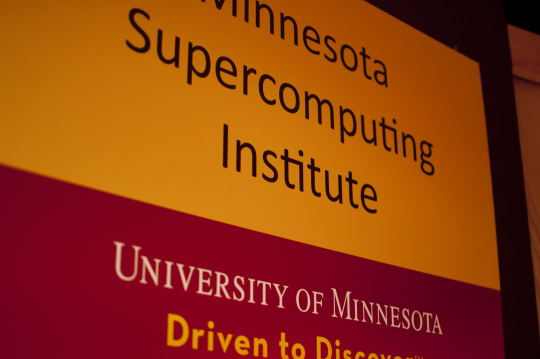
Deep in a basement under a Twin Cities campus library, Elmo, Itasca, and Blade are at work. They’re running high-level quantum calculations in the war against anthrax and other biological and chemical weapons, commanded by Elizabeth Amin.
Amin is an assistant professor of medicinal chemistry, and her three assistants are supercomputers. Blade, Itasca, and Elmo — each dressed in refrigerator-sized shiny black casings — live in a large, jammed room where the temperature fluctuates every few footsteps. They all work together in the Minnesota Supercomputing Institute for Advanced Computational Research (MSI), uncovering clues in the search to find antidotes for the causative agents of biological weapons.
The mortality rate for inhalational anthrax is 100 percent if left untreated and approaches 50 percent with early and aggressive antibiotic treatment. The antibiotics kill the anthrax bacteria but have no effect on the lethal factor (LF) enzyme — the nasty agent in anthrax that is toxic to cells — and this toxin can remain in the body for days after the bacteria are gone.
Amin’s team hopes to engineer an antitoxin drug that can be deployed to a large population at any stage of anthrax infection. Such an antidote could be used by the military in the event of a biological terrorist attack, but also in civilian populations in the developing world and in veterinary applications. She was recently awarded a $1.9 million R01 grant from the National Institutes of Health to pursue this research.
“I’m a medicinal chemist looking to mitigate the threat posed by chemical and biological warfare agents in the 21st century, while making some progress in basic scientific discovery along the way,” says Amin.
Amin’s research combines computational science, chemistry, and microbiology. The endgame, finding countermeasures to chemical and biological warfare agents, is a compelling challenge in today’s world.
“My favorite thing about this job is not knowing which discoveries might be waiting for me when I come in every day,” she says.
In conversation, Amin often pauses to think and then speaks deliberately and passionately. It’s clear she could talk about her crusade against anthrax for hours.
Humming away in the MSI, Elmo, Itasca, and Blade help Amin carry out massive computations to identify new key starting points for possible drugs, and build a therapeutic from there. The computer simulations also allow the researchers to predict properties of drugs in living systems to see how they might work against anthrax in real-world situations. Amin’s team recently screened a database of about 35 million molecules, the largest and broadest anti-anthrax drug search to date.
“From this work we were able to identify five new key drug scaffolds that look like they are very promising,” Amin explains. “They have shown some significant activity, so we’re pursuing those as potential drug leads.”
Biological warfare agents are of particular interest to Amin, who comes from a family with a long tradition of U.S. military and civil service.
From a very young age, Elizabeth Amin has known that she wanted to make scientific discoveries. It was only a matter of deciding which discipline to pursue. As a child, she was interested in uncovering underlying structures and hidden patterns in nature.
“I enjoyed mixing and melting things,” she says. “Chemistry was a natural choice for me. It also provided a solid foundation for me to explore other, related scientific disciplines. ”
After earning her Ph.D. in chemistry at the University of Missouri, Amin worked as an application scientist in the private sector. She came to the University to get back to her own research in 2004. She also teaches in the Master of Science in Security Technologies program and in the College of Pharmacy; she was chosen Professor of the Year in 2010 by the Pharm.D. class of 2012.
When she’s not fighting to secure the United States against terrorist attacks or nurturing the next wave of scientific pioneers, Amin enjoys flying as a private pilot. She’s also an avid “ham” radio operator who likes to tinker with vintage radio sets. She loves to uncover the complexities of the world around her and is excited to see her research help people.
“I consider it a privilege to be able to help support and protect those who are serving our nation now,” she said. “It is fascinating to work in an area where I can pursue key questions in basic science that involve multiple fields, including computational sciences, security technologies, biochemistry, veterinary medicine, and microbiology.”